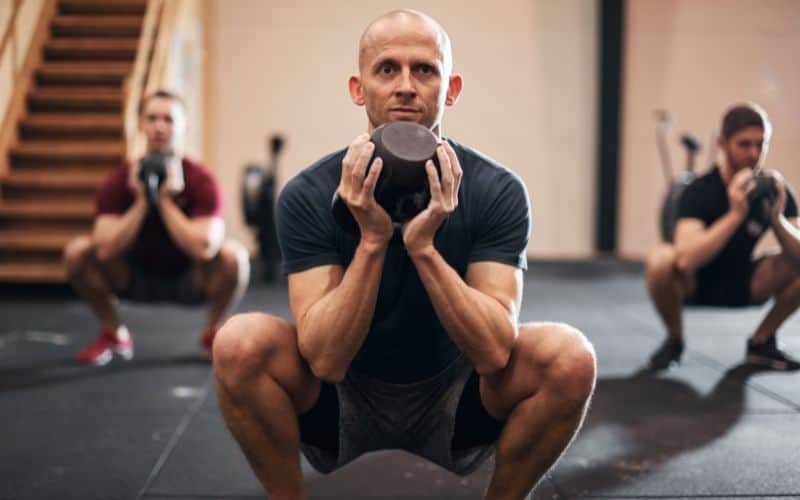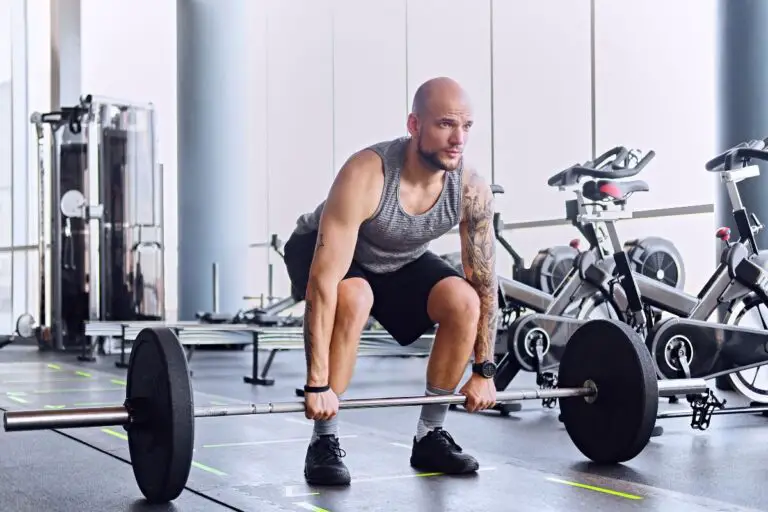Cyclists often overlook the power of weight training.
Endurance is crucial, but so is muscular strength for cyclists. Many focus solely on their legs, ignoring the holistic strength benefits. Integrating weight training can significantly enhance cycling performance, from hill climbs to sprints.
Embrace a balanced approach for a transformative cycling experience.
Fundamentals of Weight Training for Cycling Performance
Integrating weight training focused on strength, core stability, and technique can significantly enhance your cycling performance.
Understanding Cycling Strength Training
When you start strength training as a cyclist, you aim to build muscular strength that complements your cycling technique.
You’re not looking to bulk up like a bodybuilder; your goal is to enhance the power and endurance of your muscles, which translates to improved cycling performance.
By incorporating exercises that focus on the muscles used in cycling, such as squats for leg strength and stability, you’re directly benefiting your ability to pedal with more power and for longer periods.
Muscle Groups to Target for Cycling:
- Quadriceps
- Hamstrings
- Calves
- Glutes
- Core muscles
Sample Strength Training Routine:
- Squats: 3 sets of 12 reps
- Leg Curls: 3 sets of 12 reps
- Calf Raises: 3 sets of 15 reps
- Planks: 3 sets of 1 minute
- Deadlifts: 3 sets of 10 reps
Proper technique is more important than lifting heavy weights. It ensures you gain strength while minimizing injury risk.

Core Concepts in Cyclist Strength Training
Your core is your powerhouse. Enhancing core strength and stability is non-negotiable in cyclist strength training.
A strong core helps maintain proper posture on the bike, leading to more efficient pedal strokes and less fatigue. Core exercises, often overlooked, should be a staple part of your routine.
Core Exercise Examples:
- Plank: focuses on overall core stability
- Bicycle Crunches: target dynamic core strength
- Russian Twists: enhance oblique strength and rotary stability
For overall performance gains, your strength training should be periodic and progressive. Start with lower weights and higher repetitions to build endurance, and over time, transition to heavier weights and lower repetitions for power.
Maintain a balance between weight training sessions and cycling workouts to give your muscles time to recover and adapt.
Structuring Your Training Regimen
When developing your weight training program as a cyclist, you must consider the timing and types of exercises.
Periodization and Training Cycles
Periodization is a systematic approach to vary your training regimen throughout the year in cycles that align with your cycling season.
Throughout different times of the year, your cycling strength training volume and intensity will shift to complement your cycling workload and to ensure optimal recovery.
- Off-Season: Focus on building a solid foundation of muscle mass and muscular endurance with higher volume (more reps) of low-weight exercises. Aim for two to three sessions per week with high recovery time.
- Pre-Season: Transition to more cycling-specific strength with moderate weight and volume to prepare the body for the competitive season.
- In-Season: Reduce the volume and maintain strength with low-volume, high-weight sessions to avoid fatigue, usually once a week.
- Transition: After peak races, allow for recovery time with minimal strength training to help the body recover and prepare for the next cycle.
Exercise Selection for Cyclists
Your exercise selection should target the muscle groups most utilized in cycling. Aim for a blend of total body training, single-leg movements, and core stability exercises.
- Total Body Training: Implements exercises like the Superman for posterior chain development. This helps for a strong cycling position.
- Single-Leg Movements: Enhances coordination and addresses muscular imbalances. Exercises like lunges and single-leg squats are highly beneficial.
- Core Stability: Focus on exercises to strengthen the core, pivotal for power transfer and preventing injuries.
Your sessions should progressively become more challenging to continue muscle growth and strength improvement. However, always prioritize form to maximize the benefits and prevent injury.
Essential Weight Training Exercises for Cyclists
Lower Body Strength Development
Your cycling power comes from your lower body, so developing strength in these muscles is crucial. Here’s a simple table to guide your lower body routine:
| Exercise | Equipment Needed | Target Muscles |
|---|---|---|
| Squats | Bodyweight to start, Progress to barbell or dumbbells | Quads, Glutes, Hamstrings |
| Deadlifts | Barbell, Dumbbells, or Kettlebell | Hamstrings, Glutes, Lower Back |
| Lunges | Bodyweight to start, Progress to holding weights | Quads, Glutes |
Upper Body Strength and Stability
While cycling is predominantly a lower-body sport, upper-body strength is vital for bike control and overall stability. Key exercises include:
- Bench Press: Builds pushing strength in your chest, triceps, and shoulders. Begin with push-ups and then progress to a flat bench with an appropriate weight.
- Pull-Ups or Rows: Enhances pulling strength, which is critical for your back and biceps. If pull-ups are too challenging at first, start with rows using a barbell or dumbbell.
Core and Back Enrichment
A strong core and back are fundamental for cycling posture and power transfer.
- Planks: Strengthen your entire core. Maintain a straight form from your shoulders to your ankles.
- Side Planks: Focus on oblique muscles for better lateral stability on the bike.
- Kettlebell Swings: Engage your back and hips as well as your core. Start with a light kettlebell to master the hip hinge motion.
Injury Prevention and Mobility Enhancement
Incorporating mobility and stretching exercises into your routine can fortify your body against injury.
Effective Stretching and Recovery Techniques
- Dynamic Stretching: Engage in dynamic stretches before workouts to prepare your muscles and joints for the activity ahead. Examples include leg swings, which improve hip mobility, and walking lunges, which activate your lower body muscles.
- Post-Workout Stretching: After cycling, focus on static stretches to help relax your muscles and enhance flexibility. Stretching the hip flexors, hamstrings, and calf muscles is crucial as they are often tight in cyclists.
- Recovery: Giving your body adequate time to recover can prevent overuse injuries. Proper recovery involves:
- Rest: Ensure you have rest days to allow full recovery and prevent DOMS (Delayed Onset Muscle Soreness).
- Nutrition: Refuel with a balanced mix of proteins and carbohydrates to aid muscle repair.
- Sleep: Aim for 7-9 hours of quality sleep per night to facilitate bodily repair and recovery.
Maintaining Joint Health and Muscle Balance
Be aware of your body’s weaknesses and work on them; muscle imbalances can lead to poor posture and increased injury risk. Incorporate unilateral movements that work each side of the body independently to address these imbalances.
A balanced strength training and mobility approach will stave off injuries and contribute to a more robust and efficient cycling form.
Measurement and Adaptation
Carefully track your progress and adjust your workouts for optimal performance and recovery. Here’s how to monitor your improvements and fine-tune your exercise sessions for better results.
Tracking Progress and Performance Metrics
To measure your progress, you should track performance metrics that reflect your cycling economy and strength gains from weight training.
- Performance: Monitor your cycling economy by observing changes in power output at a given heart rate. An improvement here indicates increased efficiency.
- Recovery: Keep an eye on your recovery times. Faster recovery can signal improved endurance and muscle adaptation.
- Progress: Use a Training Stress Score (TSS) to quantify the load of your cycling and weight training sessions and their effect on your body.
Create a simple table like the one below to log your metrics after each workout:
| Date | Workout Type | Power Output (Watts) | Heart Rate (bpm) | Recovery Time | TSS |
| 01/02/2024 | Weight | N/A | N/A | 24 hrs | 40 |
| 01/02/2024 | Cycling | 250 | 150 | 36 hrs | 80 |
Review this data over time to assess your gains in power endurance and explosive power, especially during sprinting efforts.
Adjusting Workouts for Optimized Gains
Once you have established a baseline and regularly track your performance, you need to adjust your workouts progressively for optimized gains.
- High Weight/Low Rep vs. Low Weight/High Rep: Depending on your goals, vary your weight training between high weight and low reps for strength and low weight and high reps for endurance.
- Cycling Specific Drills: Focus on full-body exercises that mimic the cycling motion to improve your sprinting and overall cycling performance.
Your body’s response to training should guide these adjustments, ensuring a steady upward trajectory in your cycling performance.
Frequently Asked Questions
How often should a cyclist engage in weight training for optimal performance?
For optimal cycling performance, it’s recommended that cyclists incorporate weight training into their routine 2-3 times per week.
This frequency allows for significant strength gains while ensuring adequate recovery time—balance weight training with cycling workouts to help build endurance building and prevent overtraining.
Can lifting weights significantly enhance a cyclist’s strength and overall cycling ability?
Absolutely! Lifting weights can significantly boost a cyclist’s strength, particularly in the core and lower body.
This enhanced strength improves pedaling power and efficiency, improving hill climbing and sprinting abilities. Weight training also aids in injury prevention, a key aspect for any endurance athlete.
Are squats a beneficial exercise for improving riders’ cycling performance?
Squats are incredibly beneficial for cyclists. They strengthen the quadriceps, hamstrings, and glutes, which are the primary muscles used in cycling. Performing squats regularly can lead to improvements in pedaling power, endurance, and overall cycling efficiency.
What is a good strength training program for cyclists wanting to train at home?
A good home-based strength training program for cyclists should include bodyweight exercises like squats, lunges, calf raises, and resistance band workouts for added intensity.
Incorporating stability exercises, such as planks and single-leg deadlifts, can also enhance core strength and balance.

